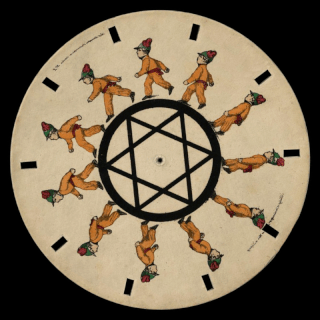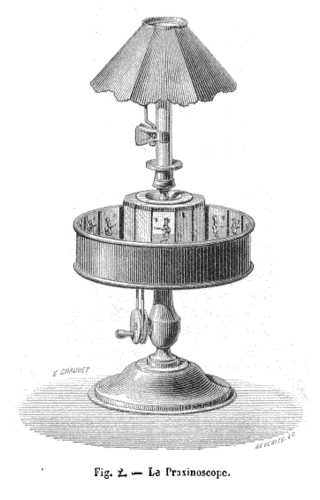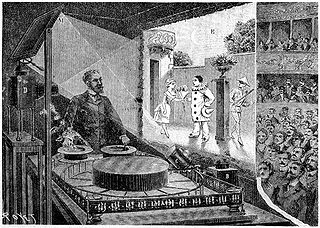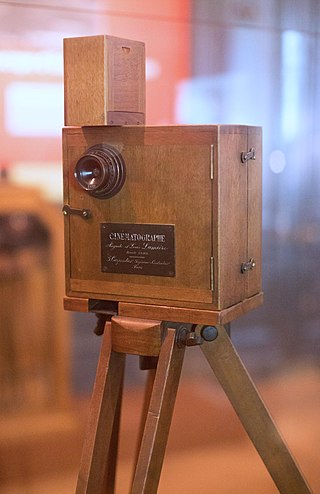Related Research Articles

The magic lantern, also known by its Latin name lanterna magica, was an early type of image projector that used pictures—paintings, prints, or photographs—on transparent plates, one or more lenses, and a light source. Because a single lens inverts an image projected through it, slides were inserted upside down in the magic lantern, rendering the projected image correctly oriented.

A zoetrope is a pre-film animation device that produces the illusion of motion, by displaying a sequence of drawings or photographs showing progressive phases of that motion. A zoetrope is a cylindrical variant of the phénakisticope, an apparatus suggested after the stroboscopic discs were introduced in 1833. The definitive version of the zoetrope, with replaceable film picture film strips, was introduced as a toy by Milton Bradley in 1866 and became very successful.

The phenakistiscope was the first widespread animation device that created a fluid illusion of motion. Dubbed Fantascope and Stroboscopische Scheiben by its inventors, it has been known under many other names until the French product name Phénakisticope became common. The phenakistiscope is regarded as one of the first forms of moving media entertainment that paved the way for the future motion picture and film industry. Similar to a GIF animation, it can only show a short continuous loop.

The praxinoscope was an animation device, the successor to the zoetrope. It was invented in France in 1877 by Charles-Émile Reynaud. Like the zoetrope, it used a strip of pictures placed around the inner surface of a spinning cylinder. The praxinoscope improved on the zoetrope by replacing its narrow viewing slits with an inner circle of mirrors, placed so that the reflections of the pictures appeared more or less stationary in position as the wheel turned. Someone looking in the mirrors would therefore see a rapid succession of images producing the illusion of motion, with a brighter and less distorted picture than the zoetrope offered.

A slide show, or slideshow, is a presentation of a series of still images (slides) on a projection screen or electronic display device, typically in a prearranged sequence. The changes may be automatic and at regular intervals or they may be manually controlled by a presenter or the viewer. Slide shows originally consisted of a series of individual photographic slides projected onto a screen with a slide projector, as opposed to the video or computer-based visual equivalent, in which the slides are not individual physical objects.

Precursors of film are concepts and devices that have much in common with the later art and techniques of cinema.

The Théâtre Optique is an animated moving picture system invented by Émile Reynaud and patented in 1888. From 28 October 1892 to March 1900 Reynaud gave over 12,800 shows to a total of over 500,000 visitors at the Musée Grévin in Paris. His Pantomimes Lumineuses series of animated films include Pauvre Pierrot and Autour d'une cabine. Reynaud's Théâtre Optique predated Auguste and Louis Lumière's first commercial, public screening of the cinematograph on 28 December 1895, which has long been seen as the birth of film.

The history of film technology traces the development of techniques for the recording, construction and presentation of motion pictures. When the film medium came about in the 19th century, there already was a centuries old tradition of screening moving images through shadow play and the magic lantern that were very popular with audiences in many parts of the world. Especially the magic lantern influenced much of the projection technology, exhibition practices and cultural implementation of film. Between 1825 and 1840, the relevant technologies of stroboscopic animation, photography and stereoscopy were introduced. For much of the rest of the century, many engineers and inventors tried to combine all these new technologies and the much older technique of projection to create a complete illusion or a complete documentation of reality. Colour photography was usually included in these ambitions and the introduction of the phonograph in 1877 seemed to promise the addition of synchronized sound recordings. Between 1887 and 1894, the first successful short cinematographic presentations were established. The biggest popular breakthrough of the technology came in 1895 with the first projected movies that lasted longer than 10 seconds. During the first years after this breakthrough, most motion pictures lasted about 50 seconds, lacked synchronized sound and natural colour, and were mainly exhibited as novelty attractions. In the first decades of the 20th century, movies grew much longer and the medium quickly developed into one of the most important tools of communication and entertainment. The breakthrough of synchronized sound occurred at the end of the 1920s and that of full color motion picture film in the 1930s. By the start of the 21st century, physical film stock was being replaced with digital film technologies at both ends of the production chain by digital image sensors and projectors.

Barrier-grid animation or picket-fence animation is an animation effect created by moving a striped transparent overlay across an interlaced image. The barrier-grid technique originated in the late 1890s, overlapping with the development of parallax stereography (Relièphographie) for 3D autostereograms. The technique has also been used for color-changing pictures, but to a much lesser extent.
For the history of animation after the development of celluloid film, see history of animation.
Events in 1869 in animation.
Events in 1868 in animation.
Events in 1867 in animation.
Events in 1866 in animation.
Events in 1865 in animation.
Events in 1862 in animation.
Events in 1860 in animation.
Events in 1859 in animation.
Events in 1855 in animation.
References
- ↑ Musser, Charles (1990). The Emergence of Cinema: The American Screen to 1907. Vol. 1. University of California Press. p. 47. ISBN 9780520085336 . Retrieved 4 June 2017.
- ↑ Rossell, Deac (2006). "The Exhibition of Moving Pictures before 1896". KINtop: Jahrbuch zur Erforschung des frühenFilms.
- ↑ Veras, Christine (April 23, 2022). "Reanimating the History and the Forgotten Characteristics of the Zoetrope". Animation. 17: 26–48. doi:10.1177/17468477221085412. S2CID 248367347 – via SAGE.
- ↑ "Toy patent" (PDF). docs.google.com. 1867.
- ↑ Herbert, Stephen. (n.d.) From Daedaleum to Zoetrope, Part 2. Retrieved May 31, 2014.
- ↑ "Full text of "Les pupazzi noirs"" . Retrieved 13 August 2012.
- ↑ "Shadows". The Richard Balzer Collection. Retrieved 13 August 2012.
- ↑ Jouvanceau, Pierre (2004). The Silhouette Film. Pagine di Chiavari. trans. Kitson. Genoa: Le Mani. ISBN 88-8012-299-1.
- ↑ The Magic Lantern - Vol. 1. No. 2. October 1874.
- ↑ McDonough, John; Egolf, Karen (2015). The Advertising Age Encyclopedia of Advertising. Routledge. p. 81. ISBN 9781135949068 . Retrieved 2 July 2018.
- ↑ Chronological Index of Patents Applied for and Patents Granted. G.E. Eyre and W. Spottiswoode. 1869. p. 65. Retrieved 2 July 2018.
- ↑ England & Wales, National Probate Calendar (Index of Wills and Administrations), 1858–1995
- ↑ Crafton 1993, p. 7.